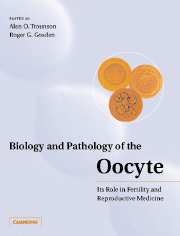Book contents
- Frontmatter
- Contents
- List of contributors
- Preface
- Part I Historical perspective
- Part II Life cycle
- 2 Ontogeny of the mammalian ovary
- 3 The early stages of follicular growth
- 4 Modelling the dynamics of ovarian follicle utilization throughout life
- 5 Comparative aspects of oogenesis
- Part III Developmental biology
- Part IV Pathology
- Part V Technology and clinical medicine
- Index
3 - The early stages of follicular growth
from Part II - Life cycle
Published online by Cambridge University Press: 05 August 2016
- Frontmatter
- Contents
- List of contributors
- Preface
- Part I Historical perspective
- Part II Life cycle
- 2 Ontogeny of the mammalian ovary
- 3 The early stages of follicular growth
- 4 Modelling the dynamics of ovarian follicle utilization throughout life
- 5 Comparative aspects of oogenesis
- Part III Developmental biology
- Part IV Pathology
- Part V Technology and clinical medicine
- Index
Summary
Introduction
The mammalian ovary contains a stock of resting follicles (Figure 3.1). Each day, a number of these follicles is activated to enter the growth phase characterized by both proliferation of granulosa cells (GCs) and enlargement of the oocyte. As the GCs proliferate, the number of GC layers around the oocyte increases (Figures 3.2.1, 3.2.2). Later in development, a fluid-filled cavity (antrum) forms in the follicles (Figure 3.2.3). When antral follicles reach a diameter of approximately 0.2-0.3 mm in rodents (Figure 3.2.4), and 2-5 mm in humans (Figure 3.2.5), they become highly responsive to follicle-stimulating hormone (FSH). Because some of these follicles in rodents, and one in humans, will be selected for further maturation and ovulation, these follicles have been named selectable follicles (Gougeon, 1996). Contrary to the highly FSH-dependent folliculogenesis starting at the selectable stage, the early follicular growth, that begins with the activation of resting follicles and ends when the selectable stage is reached, is only minimally FSH dependent.
The mechanisms governing both activation of resting follicles and early follicular growth remain poorly understood. Despite a growing body of evidence showing that locally produced factors are involved in these processes, the role of gonadotropins, and especially FSH, has not yet been clearly elucidated. In this chapter, the more recent data concerning peptides produced by follicular cells and their role played during both activation of resting follicles and early follicular growth will be reviewed. In addition, the dogma that FSH may be involved neither in activation of resting follicles nor in early follicular growth will be revisited in the light of early studies suggesting that FSH may be involved in both these two processes and of recent data showing that certain autocrine/paracrine factors may act at the follicular level, either alone or in synergy with FSH.
The ovarian reserve
Ageing changes
In the human ovary, follicles begin to form during the fourth month of fetal life. Although some of these newly formed follicles start to grow almost immediately, most of them remain in a resting stage until they either degenerate or some signal(s) activate (s) them to enter the growth phase. The pool of follicles at the resting stage constitutes the ovarian reserve.
- Type
- Chapter
- Information
- Biology and Pathology of the OocyteIts Role in Fertility and Reproductive Medicine, pp. 29 - 43Publisher: Cambridge University PressPrint publication year: 2003
- 6
- Cited by



